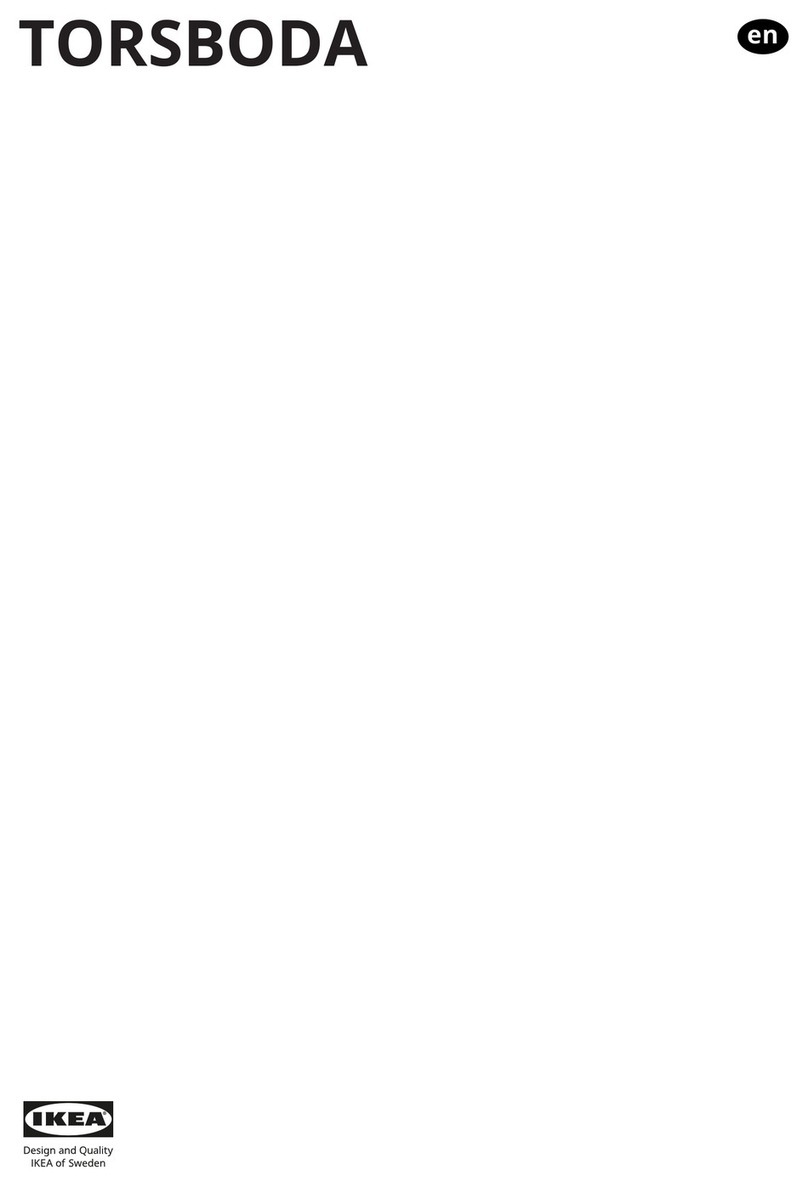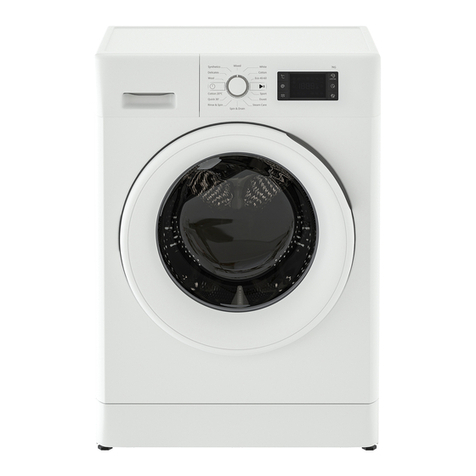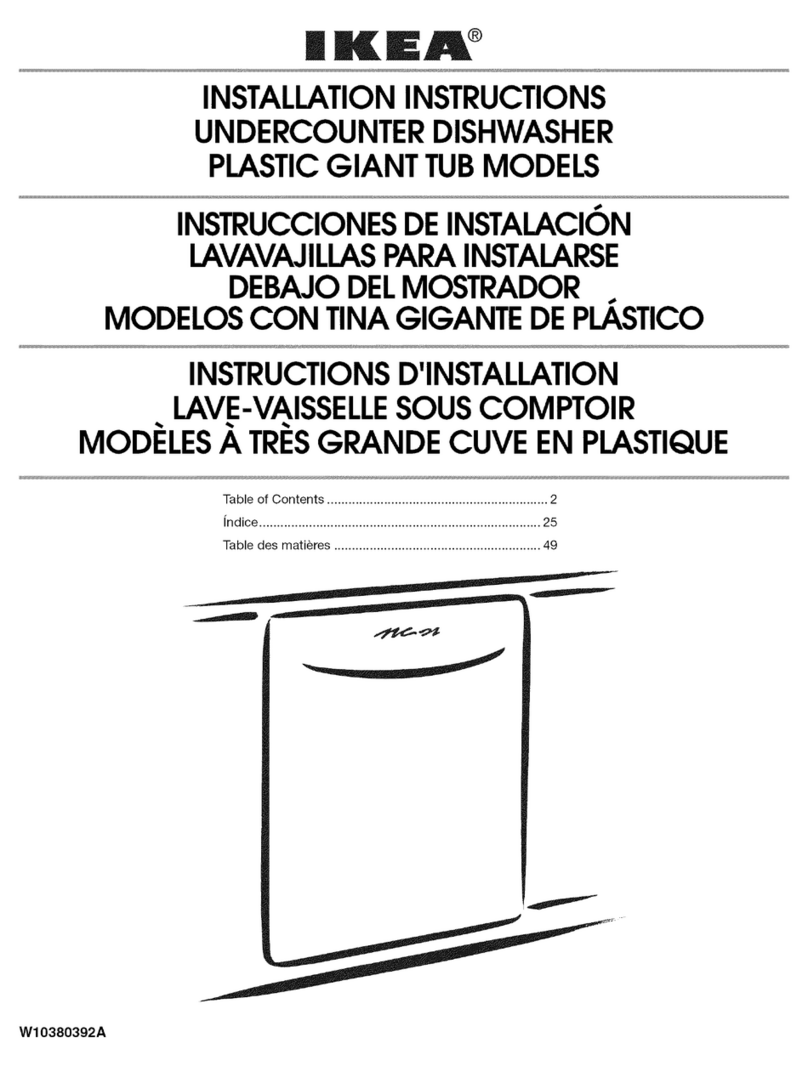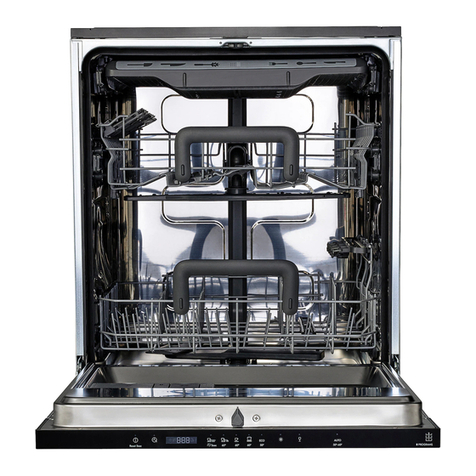IKEA SKINANDE User manual

SKINANDE
EN

2

EN
3
Safety instructions ................................................................................................................................ 4
Installation ............................................................................................................................................ 6
Product description .............................................................................................................................. 7
First time use ......................................................................................................................................... 8
Loading the racks ................................................................................................................................ 9
Programs table .................................................................................................................................... 10
Daily use .............................................................................................................................................. 10
Care and maintenance ....................................................................................................................... 11
Troubleshooting .................................................................................................................................. 12
IKEAwarranty ...................................................................................................................................... 14
ENGLISH
TABLE OF CONTENTS

EN
4
SAFETY INSTRUCTIONS
IMPORTANT TO BE READ AND OBSERVED
Before using the appliance, read these safety
instructions. Keep them nearby for future reference.
These instructions and the appliance itself provide
important safety warnings, to be observed at all
times. The manufacturer declines any liability for
failure to observe these safety instructions, for
inappropriate use of the appliance or incorrect
setting of controls.
Very young children (0-3 years) should be
kept away from the appliance. Young children
(3-8 years) should be kept away from the appliance
unless continuously supervised. Children from 8
years old and above and persons with reduced
physical, sensory or mental capabilities or lack of
experience and knowledge can use this appliance
only if they are supervised or have been given
instructions on safe use and understand the
hazards involved. Children must not play with the
appliance. Cleaning and user maintenance must
not be carried out by children without supervision.
PERMITTED USE
CAUTION: the appliance is not intended to
be operated by means of an external switching
device, such as a timer, or separate remote
controlled system.
Thisapplianceisintendedtobeusedinhousehold
and similar applications such as: staff kitchen areas
in shops, ofces and other working environments;
farm houses; by clients in hotels, motels, bed
& breakfast and other residential environments.
The maximum number of place settings is
shown in the product sheet.
The door should not be left in the open position
- risk of tripping. The open appliance door can only
support the weight of the loaded rack when pulled out.
Do not rest objects on the door or sit or stand on it.
WARNING: Dishwasher detergents are
strongly alkaline. They can be extremely
dangerous if swallowed. Avoid contact with the
skin and eyes and keep children away from the
dishwasher when the door is open. Check that the
detergent receptacle is empty after completion of
the wash cycle.
WARNING: Knives and other utensils with sharp
points must be loaded in the basket with their points
down or placed in a horizontal position - risk of cuts.
This appliance is not for professional use.
Do not use the appliance outdoors. Do not store
explosive or ammable substances (e.g. gasoline
or aerosol cans) inside or near the appliance -
risk of re. The appliance must be used only to
wash domestic dishes in accordance with the
instructions in this manual. The water in the
appliance is not potable. Use only detergent
and rinse additives designed for an automatic
dishwasher. When adding a water softener (salt),
run one cycle immediately with the machine
empty, to avoid corrosion damage to internal
parts. Store the detergent, rinse aid and salt out
of reach of children. Shut off the water supply and
unplug or disconnect the power before servicing
and maintenance. Disconnect the appliance in
the event of any malfunction.
INSTALLATION
The appliance must be handled and installed by
two or more persons - risk of injury. Use protective
gloves to unpack and install - risk of cuts. Connect
the dishwasher to the water mains using only new
hose sets. The old hose sets should not be reused.
All hoses must be securely clamped to prevent them
coming loose during operation. All local waterboard
regulations must be complied with. Water supply
pressure 0.05 - 1.0 MPa. The appliance must be
placed against the wall or built into furniture to limit
the access to its rearside. For dishwashers having
ventilation openings in the base, the openings must
not be obstructed by a carpet.
Installation, including water supply (if any) and
electrical connections, and repairs must be carried
out by a qualied technician. Do not repair or
replace any part of the appliance unless specically
stated in the user manual. Keep children away from
the installation site. After unpacking the appliance,
make sure that it has not been damaged during
transport. In the event of problems, contact the
dealer or your nearest After-sales Service. Once
installed, packaging waste (plastic, styrofoam
parts etc.) must be stored out of reach of children
- risk of suffocation. The appliance must be
disconnected from the power supply before any
installation operation - risk of electrical shock.
During installation, make sure the appliance
does not damage the power cable - risk of re or
electrical shock. Only activate the appliance when
the installation has been completed.

EN
5
If installing the dishwasher at the end of a row
of units making the side panel accessible, the
hinge area must be covered to avoid risk of
injury. The inlet water temperature depends on
the dishwasher model. If the installed inlet hose
is marked „25°C Max”, the maximum allowed
water temperature is 25°C. For all other models
the maximum allowed water temperature is 60°C.
Do not cut hoses and, in the case of appliances
tted with a waterstop system, do not immerse the
plastic casing containing the inlet hose in water.
If hoses are not long enough, contact your local
dealer. Make sure the inlet and drain hoses are
kink-free and are not crushed. Before using the
appliance for the rst time, check the water inlet
and drain hose for leaks. Make sure that the four
feet are stable and resting on the oor, adjusting
them as required, and check that the dishwasher
is perfectly levelled using a spirit level.
ELECTRICAL WARNINGS
The rating plate is on the edge of the dishwasher
door (visible when the door is open).
It must be possible to disconnect the appliance
from the power supply by unplugging it if plug is
accessible, or by a multi-pole switch installed
upstream of the socket and the appliance must
be earthed, in conformity with national electrical
safety standards.
Do not use extension leads, multiple sockets
or adapters. The electrical components must not
be accessible to the user after installation. Do not
use the appliance when you are wet or barefoot.
Do not operate this appliance if it has a damaged
power cable or plug, if it is not working properly, or
if it has been damaged or dropped.
If the supply cord is damaged, it must be
replaced with an identical one by the manufacturer,
its service agent or similarly qualied persons in
order to avoid a hazard - risk of electrical shock.
If the tted plug is not suitable for your socket
outlet, contact a qualied technician. Do not pull
the power supply cable. Do not immerse the mains
cord or plug in water. Keep the cord away from hot
surfaces.
CLEANING AND MAINTENANCE
WARNING: Ensure that the appliance is
switched off and disconnected from the power
supply before performing any maintenance
operation - risk of electrical shock. Never use
steam cleaning equipment.
DISPOSAL OF PACKAGING MATERIALS
The packaging material is 100% recyclable and is
marked with the recycle symbol . The various
parts of the packaging must therefore be disposed
of responsibly and in full compliance with local
authority regulations governing waste disposal.
DISPOSAL OF HOUSEHOLD APPLIANCES
This appliance is manufactured with recyclable or
reusable materials. Dispose of it in accordance
with local waste disposal regulations.
For further information on the treatment,
recovery and recycling of household electrical
appliances, contact your local authority, the
collection service for household waste or the
store where you purchased the appliance.
By ensuring this product is disposed of correctly,
you will help prevent negative consequences
for the environment and human health.
The symbol on the product or on the
accompanying documentation indicates that it
should not be treated as domestic waste but must
be taken to an appropriate collection center for the
recycling of electrical and electronic equipment.
ENERGY SAVING TIPS
ECO: it is the standard cleaning cycle, it is
suitable to clean normally soiled tableware and
that it is the most efcient programme in terms of
its combined energy and water consumption for
that type of tableware.
NOTE:
In order to prevent damage of the product,
please use the voltage stabilizer.

EN
6
INSTALLATION
ATTENTION: If the appliance must be moved at any time, keep it
in an upright position; if absolutely necessary, it may be tilted onto
its back.
CONNECTING THE WATER SUPPLY
Adaptation of the water supply for installation should only be
performed by a qualied technician.
The water inlet and outlet hoses may be positioned towards the
right or the left in order to achieve the best possible installation.
Make sure the dishwasher does not bend or squash the hoses.
CONNECTING THE WATER INLET HOSE
• Run the water until it is perfectly clear.
• Screw the inlet hose tightly into position and turn on the tap.
If the inlet hose is not long enough, contact a specialist store or
an authorised technician.
The water pressure must be within the values indicated in the
Technical Data table - otherwise the dishwasher may be function
properly.
Make sure the hose is not bent or compressed.
SPECIFICATIONS FOR THE CONNECTION OF THE WATER
SUPPLY HOSE:
CONNECTING THE WATER OUTLET HOSE
Connect the outlet hose to a drain duct with a minimum diameter
of 2 cm A.
The outlet hose connection must be at a height ranging from
40 to 80 cm from the oor or surface where the dishwasher rests.
Before connecting the water outlet hose to the sink drain, remove
the plastic plug B.
ANTI-FLOODING PROTECTION
Anti-ooding protection. To ensure oods do not occur, the dishwasher
is provided with a special system which blocks the water supply in
the event of anomalies or leaks from inside the appliance.
Some models are also equipped with the supplementary safety
device New Aqua Stop, which guarantees anti-ooding protection
even in the event of a supply hose rupture.
Under no circumstances should the water inlet hose be cut as it
contains live electrical parts.
ELECTRICAL CONNECTION
WARNING: Under no circumstances should the water inlet
hose be cut as it contains live electrical parts.
Before inserting the plug into the electrical socket, make sure that:
• The socket is earth and complies with current regulations;
• The socket can withstand the maximum load of the appliance
as shown on the data plate located on the inside of the door
(see PRODUCT DESCRIPTION).
• The power supply voltage falls within the values indicated on
the data plate on the inside of the door.
• The socket is compatible with the plug of the appliance.
If this is not the case, ask an authorised technician to replace the
plug (see AFTER-SALES SERVICE). Do not use extension ca-
bles or multiple sockets. Once the appliance has been installed,
the power supply cable and the electrical socket should be easily
accessible.
The cable should not be bent or compressed.
If the power supply cable is damaged, have it replaced by the
manufacturer or its authorised Technical Assistance Service in
order to prevent all potential hazards.
The Company shall not be held responsible for any incidents, if
these regulations are not observed.
POSITIONING AND LEVELLING
1. Position the dishwasher on a level sturdy oor. If the oor is
uneven, the front feet of the appliance may be adjusted until
it reaches a horizontal position. If the appliance is levelled
correctly, it will be more stable and much less likely to move or
cause vibrations and noise while it is operating.
2. Before recessing the dishwasher, stick the adhesive transparent
strip under the wooden shelf in order to protect it from any con-
densation which may form.
3.Place the dishwasher so that its sides or back panel are in
contact with the adjacent cabinets or the wall. This appliance
can also be recessed under a single worktop.
4.To adjust the height of the rear foot, turn the red hexagonal
bushing on the lower central part at the front of the dishwasher
using a hexagonal spanner with an opening of 8 mm. Turn the
spanner in a clockwise direction to increase the height and in
an anticlockwise direction to decrease it.
DIMENSIONS AND CAPACITY:
MIN 40 cm
MAX 80 cm
WATER SUPPLY cold or hot (max. 60°C)
WATER INTAKE 3/4”
POWER OF WATER
PRESSURE
0.05 ÷ 1 MPa (0.5 ÷ 10 bar)
7.25 – 145 psi
WIDTH 598 mm
HEIGHT 820 mm
DEPTH 555 mm
CAPACITY 13 standard place-settings

EN
7
1 2 3
1. Upper rack
2. Foldable aps
3. Upper rack height adjuster
4. Upper sprayer arm
5. Lower rack
6. Cutlery basket
7. Lower sprayer arm
8. Filter Assembly
9. Salt reservoir
10. Detergent and Rinse Aid dispensers
11. Rating plate
12. Control panel
1. On-Off/Reset button with indicator light
2. Program selection button
3. Program indicator lights
0000 000 00000
Service:
1
2
3
4
5
6
10
12
7
11
9
8
PRODUCT DESCRIPTION
APPLIANCE
CONTROL PANEL

EN
8
FIRST TIME USE
SALT, RINSE AID AND DETERGENT
ADVICE REGARDING THE FIRST TIME USE
After installation, remove the stoppers from the racks and the
retaining elastic elements from the upper rack.
FILLING THE SALT RESERVOIR
The use of salt prevents the formation of LIMESCALE on the
dishes andon the machine’s functional components.
• It is important that the salt reservoir be never empty.
• It is important to set the water hardness.
The salt reservoir is located in the lower part of the dishwasher
(see PRODUCT DESCRIPTION) when the green oat on the cap
of the salt reservoir is no longer visible.
1. Remove the lower rack and unscrew
the reservoir cap (anticlockwise).
2. Only the rst time you do this: ll
the salt reservoir with water.
3. Position the funnel (see gure) and
ll the salt reservoir right up to its
edge (approximately 1 kg); it is not
unusual for a little water to leak out.
4. Remove the funnel and wipe any salt residue away from the
opening.
Make sure the cap is screwed on tightly, so that no detergent can
get into the container during the wash program (this could damage
the water softener beyond repair).
As soon as this procedure is complete, run a program without
loading. The “Pre-Wash” program alone is NOT sufcient.
Residual saline solution or grains of salt can lead to corrosion,
irreparably damaging the stainless steel components.
The guarantee is not applicable if faults are caused by such
circumstances.
Only use salt that has been specically designed for dishwashers.
If the salt reservoir is not lled, the water softener and the
heating element may be damaged as a result.
Whenever you need to add salt, we recommend carrying out
the procedure just before the washing cycle is started.
SETTING THE WATER HARDNESS
To allow the water softener to work in a perfect way, it is essen-
tial that the water hardness setting is based on the actual water
hardness in your house. This information can be obtained from
your local water supplier.
The factory setting is for average (2) water hardness.
• Switch on the appliance by pressing the ON/OFF button.
• Switch off the appliance by pressing the ON/OFF button.
• Hold down button P for 5 seconds, until you hear a beep.
• Switch on the appliance by pressing the ON/OFF button.
• The program indicator light of the current set level ashes.
• Press button P to select the desired hardness level (see
WATER HARDNESS TABLE).
• Switch off the appliance by pressing the ON/OFF button.
Setting is complete!
FILLING THE RINSE AID DISPENSER
Rinse aid makes dish DRYING easier. The rinse aid dispenser A
should be lled when the dark optical indicator on the dispenser
door Cbecomes transparent.
1. Open the dispenser B by pressing and pulling up the tab on
the lid.
2. Carefully introduce the rinse aid as far as the maximum
(110 ml) reference notch of the lling space - avoid spilling it.
If this happens, clean the spill immediately with a dry cloth.
3. Press the lid down until you hear a click to close it.
NEVER pour the rinse aid directly into the tub.
ADJUSTING THE DOSAGE OF RINSE AID
If you are not completely satised with the drying results, you can
adjust the quantity of rinse aid used.
• Switch the dishwasher on using the ON/OFF button.
• Switch it off using the ON/OFF button.
• Press button P three times - a beep will be heard.
• Switch it on using the ON/OFF button.
• The program indicator light of the current set level ashes.
• Press button P to select the level of rinse aid quantity to be
supplied.
• Switch it off using the ON/OFF button
Setting is complete!
If the rinse aid level is set to ZERO (ECO), no rinse aid will be
supplied. The LOW RINSE AID indicator light will not be lit if you
run out of rinse aid. A maximum of 4 levels can be set according
to the dishwasher model. The factory setting is for a medium level.
• If you see bluish streaks on the dishes, set a low number (1-2).
• If there are drops of water or limescale marks on the dishes,
set a high number (3-4).
FILLING THE DETERGENT DISPENSER
Only use detergent which has been specically designed for
dishwashers.
To achieve the best washing and drying results, the combined
useof detergent, rinse aid liquid and rened salt is required.
We recommend using detergents that do not contain phosphates
or chlorine, as these products are harmful to the environment.
Good washing results also depend on the correct amount of
detergent being used.
Exceeding the stated amount does not result in a more effective
wash and increases environmental pollution.
The amount can be adjusted to the soil level. In the case of
normally soiled items, use approximately either 35g (powder
detergent) or 35ml (liquid detergent) and additional tea spoon of
detergent directly inside the tub. If tablets are used, one tablet
will be enough.
If the crockery is only lightly soiled or if it has been rinsed with
water before being placed in the dishwasher, reduce the amount
of detergent used accordingly (minimum 25 g/ml) e.g. skip the
powder/gel putted inside the tub.
Water Hardness Table
Level PPM
1 Soft - Medium 0 -200
2 Average 210 - 300
3 Hard 310 - 400
4 Very hard 410 - 500
M
A
X
A
B
35
25
C

EN
9
To open the detergent dispenser
press button A.
Introduce the detergent into
the dry dispenser B only.
Place the amount of detergent
for pre-washing directly inside
the tub.
1. When measuring out the detergent refer to the mentioned ear-
lier information to add the proper quantity. Inside the dispenser
Bthere are indications to help the detergent dosing.
2. Remove detergent residues from the edges of the dispenser
and close the cover until it clicks.
3. Close the lid of the detergent dispenser by pulling it up until
the closing device is secured in place.
The detergent dispenser automatically opens up at the right time
according to the program.
A
B
LOADING THE RACKS
TIPS
Before loading the baskets, remove all food residues from the
crockery and empty the glasses. You do not need to rinse before-
hand under running water.
Arrange the crockery so that it is held in place rmly and does
not tip over; and arrange the containers with the openings facing
downwards and the concave/convex parts placed obliquely, thus
allowing the water to reach every surface and ow freely.
Warning: lids, handles, trays and frying pans do not prevent the
sprayer arms from rotating.
Place any small items in the cutlery basket. Very soiled dishes
and pans should be placed in the lower basket because in this
sector the water sprays are stronger and allow a higher washing
performance.
After loading the appliance, make sure that the sprayer arms can
cotate freely.
UPPER RACK
Load delicate and light dishes:
glasses, cups, saucers, low
salad bowls.
(loading example
for the upper rack)
FOLDABLE FLAPS WITH ADJUSTABLE POSITION
The side foldable aps can be positioned at
three different heights to optimize the arrange-
ment of crockery inside the rack.
Wine glasses can be placed safely in the folda-
ble aps by inserting the stem of each glass into
the corresponding slots.
For optimum drying results incline the foldable aps
more. To change the inclination, pull up the foldable
ap, slide it slightly and position it as you wish.
ADJUSTING THE HEIGHT OF THE UPPER RACK
The height of the upper rack can be adjusted:
high position to place bulky crockery in the lo-
wer basket and low position to make the most
of the tip-up supports by creating more space
upwards and avoid collision with the items
loaded into lower rack.
The upper rack is equipped with a Upper
Rack height adjuster (see gure), without
pressing the levers, lift it up by simply holding
the rack sides, as soon as the rack is stable in
its upper position. To restore to the lower position, press the le-
vers Aat the sides of the rack and move the basket downwards.
We strongly recommend that you do not adjust the height of
the rack when it is loaded. NEVER raise or lower the basket
on one side only.
LOWER RACK
For pots, lids, plates, salad bowls, cutlery etc. Large plates and
lids should ideally be placed at the sides to avoid interferences
with the spray arm.
(loading example for the lower rack)
CUTLERY BASKET
The basket is equipped with top grilles for
improved cutlery arrangement. The cutlery
basket should be positioned only at the front
of the lower rack.
Knives and other utensils with sharp ed-
ges must be placed in the cutlery basket
with the points facing downwards or they
must be positioned horizontally in the tip-up
compartments on the upper rack.
UNSUITABLE CROCKERY
• Wooden crockery and cutlery.
• Delicate decorated glasses, artistic handicraft and antique
crockery. Their decorations are not resistant.
• Parts in synthetic material which do not withstand high temperatures.
• Copper and tin crockery.
• Crockery soiled with ash, wax, lubricating grease or ink.
The colours of glass decorations and aluminium/silver pieces can
change and fade during the washing process. Some types of glass
(e.g. crystal objects) can become opaque after a number of wash
cycles too.
DAMAGE TO GLASS AND CROCKERY
• Only use glasses and porcelain guaranteed by the manufactu-
rer as dishwasher safe.
• Use a delicate detergent suitable for crockery
• Collect glasses and cutlery from the dishwasher as soon as the
wash cycle is over.
HYGIENE
To avoid odour and sediment which can be accumulated in the
dishwasher please run a high temperature program at least once
a month. Use a tea spoon of detergent and run it without the
loading to clean your appliance.

EN
10
PROGRAMS TABLE
Programs Drying
phase
Detergent
dispenser
Duration of
wash cycle
(h:min)*
Water
consumption
(l/cycle)
Energy
cosumption
(kWh/cycle)
BTUB
1. Eco 3:10 11.0 1.04
2. Intensive - 2:30 16.5 1.65
3. Normal - 2:00 16.0 1.35
4. Pre-Wash -- - 0:10 4.0 0.01
ECO program data is measured under laboratory conditions.
* The duration of the program shown on the display or in the booklet is an estimate calculated on standard conditions. The actual time
may vary depending on many factors such as temperature and pressure of the incoming water, room temperature, amount of deter-
gent, quantity and type of load,load balancing, additional selected options and sensor calibration. The sensor calibration can increase
program duration up to 20 min.
Standby consumption: Left-on mode consumption: 5 W - Off mode consumption: 0.5 W
PROGRAMS DESCRIPTION
1. ECO - Normally soiled crockery. Standard program, the most efcient in terms of its combined energy and water consumption.
2. INTENSIVE - Program recommended for heavily soiled crockery, especially suitable for pans and saucepans (not to be used for delicate
items).
3. NORMAL - Normally soiled crockery. Everyday cycle, that ensures optimal cleaning performance in shorter time.
4. PRE-WASH - Crockery to be washed later. No detergent to be used with this program.
Notes: To reduce consumption even further, only run the dishwasher when it is full.
1. CHECK WATER CONNECTION
Check that the dishwasher is connected to the water supply
and that the top is open.
2. SWITCH ON THE DISHWASHER
Open the door and press the ON/OFF button.
3. LOAD THE RACKS
(see LOADING THE RACKS)
4. FILLING THE DETERGENT DISPENSER
(see PROGRAMS TABLE).
5. CHOOSE THE PROGRAM AND CUSTOMISE THE CYCLE
Select the most appropriate program in accordance with the
type of crockery and its soiling level (see PROGRAMS DE-
SCRIPTION) by pressing the P button.
Select the desired options (see OPTIONS AND FUNCTIONS).
6. START
Start the wash cycle by closing the door. When the program
starts you hear a beep.
7. END OF WASH CYCLE
The end of the wash cycle is indicated by beeps and by the
ashing of the indicator light of the selected program. Open
the door and switch off the appliance by pressing the ON/OFF
button. Wait for a few minutes before removing the crockery - to
avoid burns. Unload the racks, beginning with the lower one.
The machine will switch off automatically during certain
extended periods of inactivity, in order to minimise electri-
city consumption. If the crockery is only lightly soiled or
if it has been rinsed with water before being placed in the
dishwasher, reduce the amount of detergent used accordingly.
MODIFYING A RUNNING PROGRAM
If a wrong program was selected, it is possible to change it,
provided that it has only just begun: open the door (be ware of
HOT steam!), press and hold the ON/OFF button, the machine
will switch off.
Switch the machine back on using the ON/OFF button and select
the new wash cycle and any desired options; start the cycle by
closing the door.
ADDING EXTRA CROCKERY
Without switching off the machine, open the door (be ware of
HOT steam!) and place the crockery inside the dishwasher.
Close the door and the cycle will begin from the point at which it
was interrupted.
ACCIDENTAL INTERRUPTIONS
If the door is opened during the wash cycle, or if there is a power
cut, the cycle stops. It starts again from the point at which it was
interrupted once the door has been closed or the electricity
supply is restored.
DAILY USE

EN
11
CARE AND MAINTENANCE
ATTENTION: Always unplug the appliance when cleaning it
and when performing maintenance work. Do not use ammable
liquids to clean the machine.
CLEANING THE DISHWASHER
Any marks on the inside of the appliance may be
removed using a cloth dampened with water and
a little vinegar.
The external surfaces of the machine and the
control panel can be cleaned using a non-abrasive
cloth which has been dampened with water. Do
not use solvents or abrasive products.
PREVENTING UNPLEASANT ODOURS
Always keep the door of the appliance ajar in order to avoid mo-
isture from forming and being trapped inside the machine.
Clean the seals around the door and detergent dispensers regu-
larly using a damp sponge. This will avoid food becoming trapped
in the seals, which is the main cause behind the formation of
unpleasant odours.
CHEKING THE WATER SUPPLY HOSE
Check the inlet hose regularly for brittleness and cracks. If dama-
ged, replace it by a new hose available through our After-Sales
Service or your specialist dealer. Depending on the hose type:
If the inlet hose has a transparent coating, periodically check if
the colour intensies locally. If yes, the hose may have a leak and
should be replaced.
For water stop hoses: check the small safety valve inspection
window (see arrow). If it is red, the water stop function was trig-
gered, and the hose must be replaced by a new one.
For unscrewing this hose, press the release button while unscre-
wing the hose.
CLEANING THE WATER INLET HOSE
If the water hoses are new or have not been used for an exten-
ded period of time, let the water run to make sure it is clear and
free of impurities before performing the necessary connections. If
this precaution is not taken, the water inlet could become blocked
and damage the dishwasher.
CLEANING THE FILTER ASSEMBLY
Regularly clean the lter assembly so that the lters do not clog
and that the waste water ows away correctly.
The lter assembly consists of three lters which remove food
residues from the washing water and then recirculate the water:
to obtain the best washing results, you need to keep them clean.
The dishwasher must not be used without lters or if the
lter is loose.
After several washes, check the lter assembly and if necessary
clean it thoroughly under running water, using a non-metallic
brush and following the instructions below:
1. Turn the cylindrical lter Ain an anti-clockwise direction and
pull it out (Fig 1).
2. Remove the cup lter Bby exerting a slight pressure on the
side aps (Fig 2).
3. Slide out the stainless-steel plate lter C(Fig 3).
4. Inspect the trap and remove any food residues. NEVER RE-
MOVE the wash-cycle pump protection (black detail) (Fig 4).
After cleaning the lters, re-place the lter assembly and x it in
position correctly; this is essential for maintaining the efcient
operation of the dishwasher.
CLEANING THE SPRAY ARMS
On occasions, food residue
may become encrusted onto
the spray arms and block the
holes used to spray the water. It
is therefore recommended that
you check the arms from time to
time and clean them with a small
non-metallic brush.
To remove the upper spray arm,
turn the plastic locking ring in an
anti-clockwise direction.
The upper spray arm should be replaced so that the side with the
greater number of holes is facing upwards.
The lower spray arm may be
removed by pulling it upwards.
A
A
B
C
12
34

EN
12
TROUBLESHOOTING
Your dishwasher may not work properly.
Before contacting the After-sales Service, check if the problem can be solved by going through the following list.
PROBLEMS POSSIBLE CAUSES SOLUTIONS
The dishwasher won’t
start or does not
respond to commands.
The appliance has not been
plugged in properly. Insert the plug into the socket.
Power outage. The dishwasher starts automatically when the power returns.
The dishwasher door is not closed. Vigorously push the door until you hear the “click”.
It does not respond to commands. Switch off the appliance by pressing the ON/OFF button, switch it
back on after approximately one minute and reset the program.
The door doesn’t lock.
Racks are not t to the end. Verify that racks are t to the end.
The door is not lock. Vigorously push the door until you hear the “clack” sound.
The dishwasher won’t drain.
The wash cycle has not nished yet. Wait until the wash cycle nishes.
The drain hose is bent. Check that the drain hose is not bent (see INSTALATION
INSTRUCTION).
The sink drain pipe is blocked. Clean the sink drain pipe.
The lter is clogged up with food
residues Clean the lter (see CLEANING THE FILTER ASSEMBLY).
The dishwasher makes
excessive noise.
The dishes are rattling against
each. Arrange the crockery correctly (see LOADING THE RACKS).
An excessive amount of foam
has been produced.
The detergent has not been measured out correctly or it is not
suitable for use in dishwashers (see FILLING THE DETERGENT
DISPENSER). Reset dishwasher by pressing the DRAIN button
(see OPTIONS AND FUNCTIONS) and run new program without
detergent.
The dishes have not been
dried.
The selected program hasn’t any
drying phase.
Verify on the programs table if the selected program has the drying
phase.
The rinse aid has run out or the
resolution is not adequate.
Add the rinse aid or adjust the dosage levels higher (see FILLING
THE RINSE AID DISPENSER).
The dishes are made of non-stick
or plastic. It is normal the presence of drops of water (see TIPS).
The dishes are not clean.
The crockery has not been arran-
ged properly. Arrange the crockery correctly (see LOADING THE RACKS).
The spray arms cannot rotate freely,
being hindered by the dishes. Arrange the crockery correctly (see LOADING THE RACKS).
The wash cycle is too gentle
and/or detergent efciency is low. Select an appropriate wash cycle (see PROGRAMS TABLE).
An excessive amount of foam
has been produced.( see AFTER-
-SALES SERVICE)
The detergent has not been measured out correctly or it is not
suitable for use in dishwashers (see FILLING THE DETERGENT
DISPENSER). Reset dishwasher by pressing the DRAIN button
(see OPTIONS AND FUNCTIONS) and run new program without
detergent.
The cap on the rinse aid compart-
ment has not been shut correctly. Make sure the cap of the rinse aid dispenser is closed.
The lter is soiled or clogged. Clean the lter assembly (see CARE AND MAINTENANCE).
There is no salt. Fill the salt reservoir (see FILLING THE SALT RESERVOIR).

EN
13
PROBLEMS POSSIBLE CAUSES SOLUTIONS
The dishwasher does not ll
the water.
No water in the water supply or
the tap is closed. Make sure there is water in the water supply or the tap running.
The inlet hose is bent. Make sure the drain hose is not bent (see INSTALLATION) repro-
gram the dishwasher and reboot.
The sieve in the water inlet hose
is clogged; it is necessary to
clean it.
After having carried out the verication and cleaning, turn off and
turn on the dishwasher and restart a new program.
The dishes and glasses
show calcination or a whi-
tish lm.
The salt level is too low. Fill the salt reservoir (see FILLING THE SALT RESERVOIR).
The adjustment of the water
hardness is not adequate. Increase the values (see WATER HARDNESS TABLE).
The cap of the salt reservoir is
not properly closed. Check to have properly closed the salt reservoir cap.
The rinse aid is used up or the
dosage is insufcient. Add the rinse aid or adjust the dosage levels higher.
The dishes and glasses
are blue streaked or have a
bluish tinge.
The rinse aid dosage is excessive. Adjust the dosage rates below.

EN
14
IKEA WARRANTY
How long is the IKEA warranty valid?
This warranty is valid for ve (5) years from the original date
of purchase of your appliance at IKEA. Proof of purchase is
required. If service work is carried out under warranty, this will not
extend the warranty period for the appliance.
Who will execute the service?
IKEA Service Provider will provide the service through its own
service operations or authorized service partner network.
What does this warranty cover?
The warranty covers faults of the appliance, which have been
caused by faulty construction or material faults from the date of
purchase from IKEA. This warranty applies to domestic use only.
The exceptions are specied under the headline “What is not
covered under this warranty?” Within the warranty period, the
costs to remedy the fault e.g. repairs, parts, labour and travel will
be covered, provided that the appliance is accessible for repair
without special expenditure. Replaced parts or appliance become
the property of IKEA.
What will IKEA do to correct the problem?
IKEA will examine the product and decide, at its sole discretion, if
it is covered under this warranty. If considered covered, IKEA will
then, at its sole discretion, either repair the defective product or if
the product is found to be not repairable in its sole discretion (a)
IKEA will replace it with the same or a comparable product or (b)
refund it as per the prevailing depreciation rules of IKEA.
What is not covered under this warranty?
• Normal wear and tear.
• Deliberate or negligent damage, damage caused by failure
to observe operating instructions, incorrect installation or by
connection to the wrong voltage, uctuating voltage, improper
electrical circuit, blown fuse, damage caused by chemical or
electrochemical reaction, rust, corrosion or water damage
including but not limited to damage caused by excessive lime
in the water supply, damage caused by abnormal environ-
mental conditions, damage caused by rodents/insects, water,
lightening, pest infestation or other acts of god.
• Consumable parts including batteries and lamps.
• Non-functional and decorative parts which do not affect normal
use of the appliance, including any scratches and possible
colour differences.
• Accidental damage caused by foreign objects or substances
and cleaning or unblocking of lters, drainage systems or soap
drawers.
• Damage to the following parts: ceramic glass, plastic parts
accessories, crockery and cutlery baskets, feed and drainage
pipes, seals, lamps and lamp covers, screens, knobs, casings
and parts of casings. Unless such damages can be proved to
have been caused by production faults.
• Repairs or any alteration not carried out by our appointed
service providers and/or an authorized service contractual
partner or where non-original parts have been used.
• The use of the appliance in a non-domestic environment i.e.
professional use or any alteration, abuse or misuse of the
appliance.
• The Serial number or barcode label of the appliance is tampe-
red with, defaced, missing or altered
• Transportation damages. If a customer transports the product
to his home or another address, IKEA is not liable for any
damage that may occur during transport. However, if IKEA
delivers the product to the customer’s delivery address, then
damage to the product that occurs during this delivery will be
covered by IKEA.
In cases the above conditions are observed at the time of visit by
the Authorized Service Center service partner then the Purchaser
shall be liable to bear the repair charges incurred during the pro-
cess and price of other parts/consumables/spares not covered
in
Warranty and/or repair charges for the parts covered under war-
ranty if the same is damaged by the Customer or otherwise gets
damaged due to non adherence to User manual or warranty terms.
How country law applies
The IKEA warranty gives you specic legal rights, which cover or
exceed all the local legal demands. However these conditions do not
limit in any way consumer rights described in the local legislation.
The courts at New Delhi have exclusive jurisdiction for settling
the claims or disputes or matters arising out of present Warranty.
Area of validity
This IKEA warranty applies only to products purchased in India.
This Warranty shall be restricted to and valid in India.
An obligation to carry out services in the framework of the warranty
exists only if the appliance complies with:
• The technical specications of the country in which the warranty
claim is made;
• The Assembly Instructions and User Manual Safety Information.
AFTER SALES for IKEA appliances
Please don’t hesitate to contact IKEA to:
• make a service request under this warranty;
• ask for clarication on functions of IKEA appliances
To ensure that we provide you with the best assistance, please
read carefully the Assembly Instructions and/or the User Manual
before contacting us.
How to reach us if you need our service
1800-419-4532
Opening time
10.00 – 22.00
The IKEA after sales customer service centre will assist you on
the phone with basic trouble shooting for your appliance at the
time of service call request.
In order to provide you a quicker service, please also always
refer to the IKEA article number (8 digit code) placed on the
rating plate of your appliance.
While IKEA will make every effort to carry out repairs/ repla-
cement of parts under this Warranty as soon as possible; it is
expressly made clear that IKEA or its authorised service partner
shall not be liable to do so within specied period of time.
It is entirely left to IKEA’s discretion to effect repairs/replacements
of parts at the site of installation or at any service station of its
Authorized Service Center(s).
SAVE THE PROOF OF PURCHASE!
It requires for the warranty to apply. The proof of purchase also
reports the IKEA name and article number (8 digit code) for each
of the appliances you have purchased.
Do you need extra help?
For any additional questions not related to After Sales of your
appliances please contact your nearest IKEA store call centre.
We recommend you read the appliance documentation carefully
before contacting us.
IKEA reserves the right to alter the terms and conditions of the
present Warranty at any time with its sole discretion without any
prior notice.

15

Printed in Italy 01/18
400011177443C
23218
AA-2040533-4
EN
Other manuals for SKINANDE
13
Table of contents
Other IKEA Dishwasher manuals
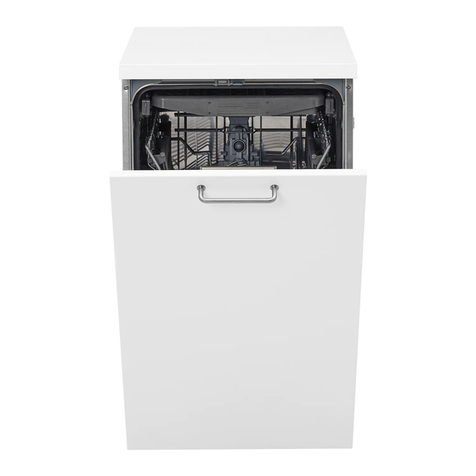
IKEA
IKEA finputsad User manual
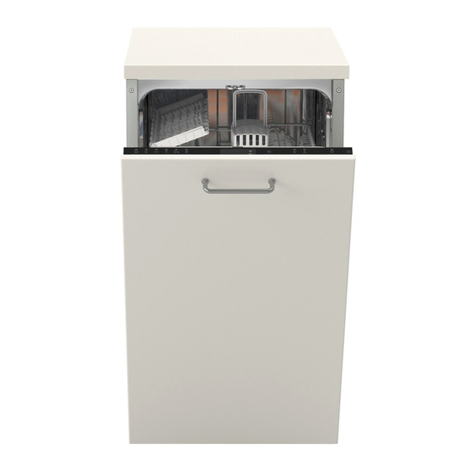
IKEA
IKEA LAGAN User manual

IKEA
IKEA SKINANDE User manual

IKEA
IKEA SKINANDE User manual
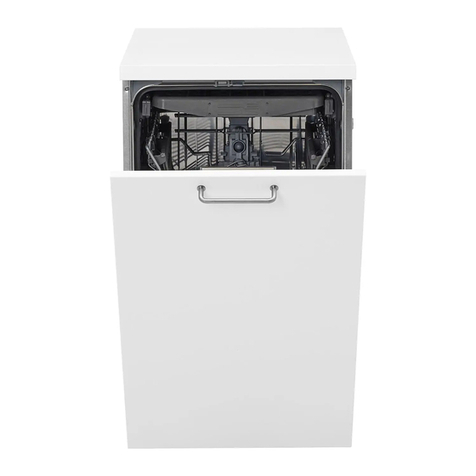
IKEA
IKEA FINPUTSAD 700 User manual

IKEA
IKEA ENASTAENDE User manual
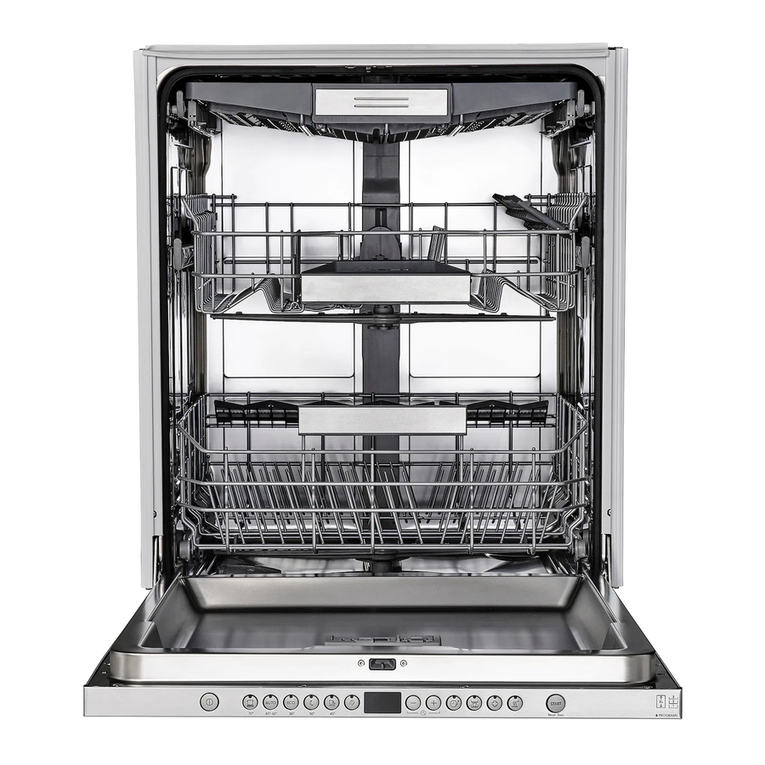
IKEA
IKEA PROFFSIG User manual
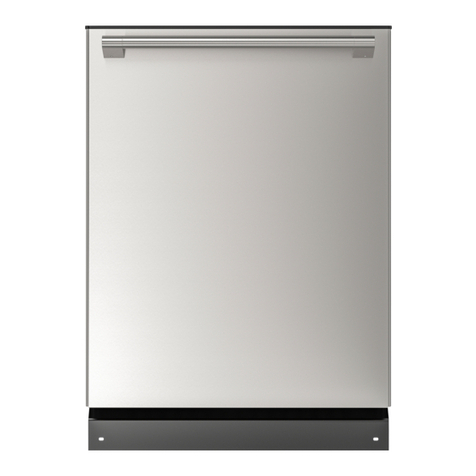
IKEA
IKEA ESSENTIELL 804.655.85 User manual

IKEA
IKEA LAGAN User manual

IKEA
IKEA LAGAN User manual

